Build It: Half-Height Gaming PCs For The Living Room
PowerColor’s half-height Radeon HD 5750 launched a quest to build a tiny gaming PC. But things didn't work out the way we planned. We ended up building two half-height machines capable of cranking out playable frame rates, and put them both to the test.
Half-Height Build #1: Say Hello To My Little Friend
PowerColor’s half-height Radeon HD 5750 is a dual-slot card, so, in theory, all we should have to do is find the smallest half-height case available that can accommodate two half-height expansion slots. While this sounds simple enough, it turns out that mini-ITX cases with two half-height expansion slots are quite rare.
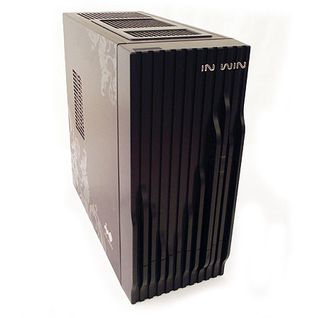
A great deal of searching lead us to In-Win, a case manufacturer that offers an eclectic selection of product configurations. In-Win has a number of half-height PC cases, two of which feature dual expansion slots: the Wavy and the Diva. While the Diva is extremely pretty and colorful, it does not appeal to this reviewer’s gender in name or in form. We choose the Wavy.
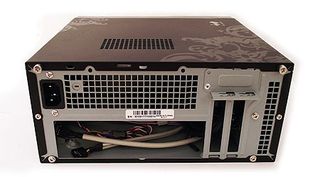
The Wavy is a small case: 264 x 112 x 230 mm compared to the Xbox 360 Slim’s 270 x 75 x 264 mm--definitely in the same league as the console, although the Wavy is a little thicker. The test sample that In-Win supplied comes equipped with a 160 W power supply. The Wavy (with its power supply) can be purchased at In-Win's Web store: estore.in-win.us. There is a new model with a 180 W power supply in development, but either way, we’ve run into our first major snag: this probably isn’t enough juice to power the system including PowerColor’s half-height Radeon HD 5750.
Let’s set that issue aside for a moment, though, and move on to motherboard choices. When small is the name of the game, mini-ITX motherboards are the way to go. For an ultra-low power gaming machine, our wish list includes a Mobile Core i7 CPU like the -640M or the -920QM. Unfortunately, there aren’t a lot of Socket G1 mini-ITX motherboards available, and we couldn’t find one at retail with a x16 PCIe slot for the discrete graphics card.
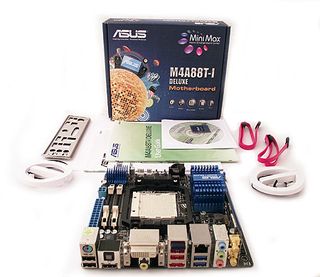
In fact, there aren’t a lot of mini-ITX boards with 16-lane PCIe slots at all. In the end, we chose Asus’ M4A88T-I Deluxe, a mini-ITX board with all the bells and whistles including in integrated wireless LAN card and AMD's 880G chipset. This board supports AMD’s Socket AM3 interface and laptop-style DDR3 SO-DIMM memory.

Speaking of memory, we chose Mushkin Enhanced Essentials 4 GB (2 x 2 GB) SO-DIMM DDR3-1066 (PC3-8500) dual-channel kit. This should provide excellent performance in conjunction with low power usage. The motherboard automatically set this RAM to run at 1333 MT/s without incident.
We’re also using AMD's Phenom II X3 705e processor for this PC because of its relatively low 65 W TDP, triple-core architecture, and 6 MB L3 cache. The 2.5 GHz clock speed is a little lower than AMD's higher-end Phenom II chips, but that's one of the compromises we need to make in order to dip under the enclosure's 160 W ceiling.
Stay On the Cutting Edge: Get the Tom's Hardware Newsletter
Join the experts who read Tom's Hardware for the inside track on enthusiast PC tech news — and have for over 25 years. We'll send breaking news and in-depth reviews of CPUs, GPUs, AI, maker hardware and more straight to your inbox.
With a Western Digital Black 750 GB drive added to the mix, we’re ready to put the system together. Squeezing the mini-ITX motherboard in the Wavy case isn’t as simple as we assumed it would be, but a little careful wiggling gets the board seated properly. At this point, we dropped in the PowerColor Radeon HD 5750.

Correction: we tried to plug in the half-height PowerColor Radeon HD 5750; it's too long to fit inside the Wavy case. The height is fine, but the back of the card extends about an inch too far for this case, and is blocked by the power supply.
PowerColor’s card may have been the raison d'être for this build, but that wasn't going to stop us from going the distance and finishing it up. We used the half-height Radeon HD 5570 instead. It's naturally not as fast as the Radeon HD 5750 when it comes to games, but it can certainly handle 720p, and might be able to pull off 1080p at reduced detail settings.
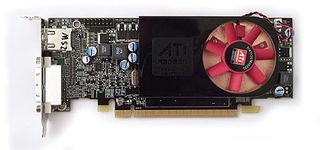
The Radeon HD 5570 fit like a glove and the rest of the build came together nicely. The cramped space presented us with a couple of more unpleasant surprises, but nothing we couldn't handle. We were forced to cut the plastic retaining clip off of the four-pin motherboard power cable because it interferes with the case fan, and we couldn't use a full-sized internal optical drive because it would literally smother the CPU fan. Ideally, a slimline optical drive would provide the space we need to give the CPU some breathing room, but for our purposes, an external drive did the trick. We used Asus’ SBW-06C1S-U 6x external Blu-ray writer to complement our build--a convenient choice, since it requires no external power. The drive runs off of the power drawn from two USB ports.
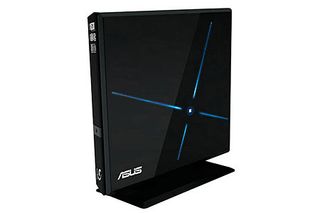
Our smallest HTPC build was ready to go. But what about the half-height PowerColor HD 5750 that had to be abandoned?

Current page: Half-Height Build #1: Say Hello To My Little Friend
Prev Page How Low Can You Go? Next Page Half-Height Build #2: Go Wide!-
Poisoner This is an interesting article and goes a direction where nVidia has no way to compete.Reply -
dirtmountain Good article and an interesting read. You can get a half height GTS450. http://www.newegg.com/Product/Product.aspx?Item=N82E16814261078Reply -
fatkid35 awesome article. i love small pc's! my silverstone sg05 is modded with a 600 watt psu and 6870 stuffed inside.Reply -
shovenose the antec sp-400 has issues! it has lousy fuhjyyu capactiros that fail even just sitting there. i suggest you find a different psu!Reply -
cleeve shovenosethe antec sp-400 has issues! it has lousy fuhjyyu capactiros that fail even just sitting there. i suggest you find a different psu!Reply
I've been using this one in my main HTPC for a couple years now at least. Haven't had any problems.
-
carlhenry that's weird, a 160w power supply powering up a 5570? (and you also intended to slap in the 5750 there?) did i miss something?Reply -
dEAne Looking for a case like that is next to impossible - but for a 160W wow I never have though of that, it gives me another idea. thanks tom.Reply -
Th-z Thanks for the article. I have a question, where do you find quality small PSU? If you want to go as small as you can, one would need to use small PSU. But it seems they are scarce in terms of wattage selection and brand, no where comparing to standard ATX PSU.Reply
Many small mini-ITX cases do include a small PSU, but what if you want to mod the PSU, or the included one breaks down? Falling back to standard ATX PSU would have to use a bigger mini-ITX case.
Most Popular



